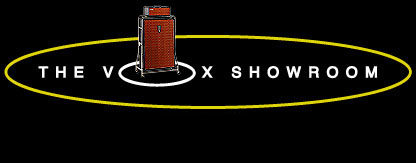In late 1963, Vox scurried the first fifty watt AC-50 amps to the John Lennon and George Harrison of the Beatles. The output of their former AC-30 amps proved to be no match for the screaming girls in their audiences. In less than a year and a string of #1 records later, the AC-50s fared little better. Vox responded with even bigger and louder amps. They nearly doubled both the wattage of the AC-50 head and designed a 4x12 cabinet with two Midax horns to make the AC-100 "80-100 Watt Amplifier".
The AC-100 was probably the largest production guitar amp in the world when it was introduced in 1964. The prior reigning king of guitar amps, the Fender Dual Showman, was dwarfed by AC-100.
The AC-100 was outwardly very simple. The single channel amp head had two inputs and three controls: Volume, Treble and Bass. The only other items that graced the deep red control panel were a power switch, a fuse holder, a voltage selector and dual 1/4" inputs. The amp head produced a clean 80 watts RMS.
The "thin edge" head cabinet was very compact, only seven inches tall and nineteen inches wide and made of 3/8" baltic birch plywood. Due to the tremendous amount of heat developed by four EL-34 power tubes, a large vent hole consumed most of the bottom of the head cabinet. A second, smaller air vent was on the top of the amp.
The amp head had "perfect" vinyl covered corners without plastic protective corner caps. A single Vox carrying handle was on the top of the cabinet.
The AC-100 speaker cabinet was essentially the "Small Box" AC-50 speaker cabinet seen in "A Hard Day's Night," but doubled. The cabinet was 40" tall, 27.25" wide, and 11" deep without the trolley stand. Four Celestion/Vox Alnico 12" speakers and two Goodmans Midax horns with 2 uf crossover capacitors filled the open backed cabinet.
The quality and attention to detail of JMI Vox cabinetry is stunning. The baffle (speaker) board was fastened to the cabinet with fourteen machine screws and nuts. Vox did not depend on wood screws to retain the front panels, as done by other amp manufacturers such as Fender and Gibson. Even the three back panels were secured with machine screws theaded into metal inserts mounted in the back strips of the cabinet.
A tubular chrome plated swivel trolley stand was also devised for the AC-100. The speaker cabinet and trolley towered four feet above the ground even before the amp head was placed on top of the stand. Adding the head made the amp stand over 55" inches above the floor.



